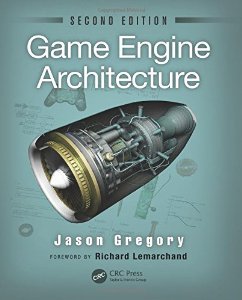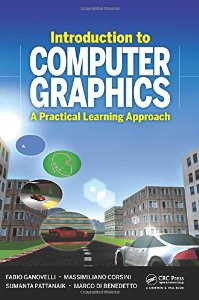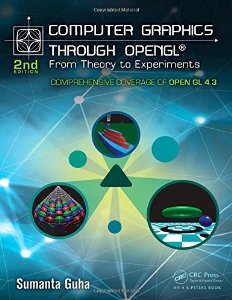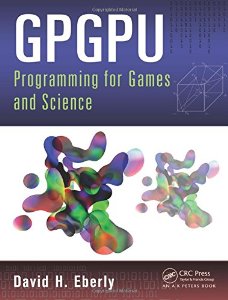Well, newish books, from the past year. By the way, I’ve also updated our books list with all relevant new graphics books I could find. Let me know if I missed any.
This post reviews four books from CRC Press in the past year. Why CRC Press? Because they offered to send me books for review and I asked for these. I’ve listed the four books reviewed in my own order of preference, best first. Writing a book is a ton of work; I admire anyone who takes it on. I honestly dread writing a few of these reviews. Still, at the risk of being disliked, I feel obligated to give my impressions, since I was sent copies specifically for review, and I should not break that trust. These are my opinions, not my cat’s, and they could well differ from yours. Our own book would get four out of five stars by my reckoning, and lower as it ages. I’m a tough critic.
I’m also an unpaid one: I spent a few hours with each book, but certainly did not read each cover to cover (though I hope to find the time to do so with Game Engine Architecture for topics I know nothing about). So, beyond a general skim, I decided to choose a few graphics-related operations in advance and see how well each book covered them. The topics:
- Antialiasing, since it’s important to modern applications
- Phong shading vs. lighting, since they’re different
- Clip coordinates, which is what vertex shaders produce
 Game Engine Architecture, Second Edition, by Jason Gregory, August 2014 (book’s extensive website, Google Preview and Table of Contents)
Game Engine Architecture, Second Edition, by Jason Gregory, August 2014 (book’s extensive website, Google Preview and Table of Contents)
Overall this is a pretty great book. It’s not meant as a graphics programming guide; rather, it’s more a course about all the aspects of actually programming a videogame. I’m impressed with its quick summaries of hundreds of different algorithms, techniques, and tools and what each is used for. It performs a valuable service, alerting the reader that a topic even exists and giving some sense of what it’s about, all in plain English. The main problem with writing about current practices is that the book is about two years old, so of course some newer techniques and tools are not covered. However, it gets you about 90% up to speed. The book is not full color, rather has color plates, and that’s just as well. Full color throughout would have been expensive and made the book quite heavy (possibly unpublishable) without adding a lot of value.
Antialiasing: generally good coverage, though it assumes the reader already knows what jaggies actually are. Discusses MSAA and FXAA, and notes the idea of MLAA. MSAA is described correctly and clearly. FSAA is covered briefly and (properly) dismissed. CSAA is covered, since at the time it was a thing. SMAA is not discussed, since it hadn’t really been picked up by games yet at the time of writing. There’s a minor typo on page 506, “4 X MLAA” when MSAA is meant.
Phong: the term Phong doesn’t appear in the index. Perhaps this is fair enough for Phong shading, which is often replaced with the more descriptive term “per pixel shading”. I blame my age and schooling for considering these to be important terms. This book has a bit of confusion on the subject, however, mixing per pixel evaluation with the implication that texture mapping fixes Gouraud shading artifacts (p. 462). This is too bad – I want to like everything about this book, since it gets so much correct. Phong illumination is not in the index, nor is Blinn-Phong. I did finally find Blinn-Phong and Phong under “lighting” in the index. In general the index is somewhat weak, as it has less cross-referencing than I would like. Presentation of Blinn-Phong is short and succinct, which is appropriate for the survey nature of this book. A set of thumbnails showing the effect of changing the exponent would have been useful. A long Wikipedia URL is given for more information; better would have been to say “Search on ‘Blinn-Phong’ on Wikipedia”, since no one will type in the URL.
Clip coordinates: Clip coordinates for a perspective view usually have a W value that’s not 1, and clipping is done on points that have X, Y, or Z values that are outside the range [-W,W] (when W is positive). Clip coordinates are what the vertex shader produces, so are important to understand properly. Unfortunately, this book gets this topic a bit wrong, but so do most texts. This text mixes clip space with Normalized Device Coordinates (NDC). This is a common “shorthand” used to explain clipping, but something of a false savings. We as humans tend to think about clipping against the NDC coordinates, but clip space is where clipping actually happens, before dividing by W. The book does point out something that is (surprisingly) rarely mentioned in other books, that along the z-axis NDC goes from 0 to 1 for DirectX.
Summary: despite my criticisms, four out of five stars, maybe higher. It covers a huge number of subjects, has much practical advice (e.g., performance and debugging tool recommendations), and is written in a clear and intelligent style. The author clearly cares about his subject and does his best to help the reader learn all about it. As important, he cuts the fluff – I didn’t see any signs of pet topics he cares deeply about that mostly don’t matter to the field. Finally, at $62.96 for a thousand-plus page book, a great price per page.
 Introduction to Computer Graphics: A Practical Learning Approach, by Fabio Ganovelli, Massimiliano Corsini, Sumanta Pattanaik, and Marco Di Benedetto, October 2014 (Google Preview and Table of Contents, authors’ website, publisher’s page)
Introduction to Computer Graphics: A Practical Learning Approach, by Fabio Ganovelli, Massimiliano Corsini, Sumanta Pattanaik, and Marco Di Benedetto, October 2014 (Google Preview and Table of Contents, authors’ website, publisher’s page)
This book is about computer graphics in general. It has a focus on interactive techniques and uses WebGL for exercises (good plan!), but also tries to give a wider view of the field. Theory is favored over practice. One factor in favor of this book is that I haven’t (yet) found any serious errors. I would expect no glaring errors from these authors, researchers all. However, there are omissions or short explanations where a bit more ink would have been useful, along with a number of typos for important terms. At 375 pages (not including table of contents), this book overall feels condensed, given its scope. I sometimes found it terse and quick to jump to equations without enough background. To its credit, there are many helpful figures. The book suffers from not being fully in color, rather including just some color plates. The small book page size makes the text feel a bit crowded.
Antialiasing: somewhat abstract coverage, first talking about line rasterization in HSV space. Mentions full-screen antialiasing, mislabelling it FSSA, but fails to note that this is rarely done in practice. Important antialiasing techniques for interactive rendering, such as MSAA and FXAA/SMAA/MLAA, are not mentioned.
Phong: properly indexed and fully covered, and a warning given to the reader to not confuse shading with illumination. The difference between Phong and Blinn-Phong is covered, though it does not discuss that the exponent in each has a considerably different effect (Game Engine Architecture notes the exponent is “slightly different”, when in fact it’s about a factor of 4 different – see “R.E versus N.H Specular Highlights,” in Graphics Gems IV, also here). Oddly, fragment and vertex shaders are not listed in the index, though fragment shaders are presented in the text for the exercises. Typo, repeated in the index: “Match banding” instead of “Mach banding”.
Clip coordinates: not incorrect, just omitted. Clip space is briefly mentioned on page 117 and the text properly notes that it is not the same as NDC. Much else along the pipeline is dealt with in some depth, but clipping in homogeneous space is given a sentence. There is an interesting pipeline figure on page 121, but clipping is left out. DirectX’s range of [0,1] for the Z axis of its space is not mentioned. Classical clipping algorithms such as Sutherland-Hodgman are covered, but without mention of clip space vs. NDC space. Proper clipping for perspective views is feeling like a lost art to me. It’s an easy topic to skip – the GPU does all the clipping nowadays – but some brief coverage can help save students from screwing up the w-coordinate when writing vertex shaders. The best (and brief) online explanations I’ve seen are here and here, and by “best” I mean “basically correct”. More on this topic later.
Summary: an average of three and a half stars out of five, though it depends. This book contains solid information, could be used as a textbook for teaching graphics, or possibly a fairly-reliable (though terse) reference. It looks tough to plow through if you’re on your own, and it tends to be more theoretic than practical. In the long term, this theoretical bent is a good thing for someone learning this area – a proper foundation will serve anyone well for life, vs. memorizing ever-evolving APIs – but the book does not feel strongly connected to present-day practice. For example, it barely discusses the various types of shaders – vertex, fragment, geometry, etc. The fragment shader gets a paragraph, and no entry in the index. GLSL is mentioned but also does not have an index entry. The geometry shader is never discussed. In fairness, vertex and fragment shaders are indeed used in the WebGL exercises, there’s just not much explanation. Again, it feels like an abridged textbook, where the instructors in class would spend time on how to actually program shaders. I look forward to a second edition that is more fleshed out.
GPGPU Programming for Games and Science, by David H. Eberly, August 2014 (book’s code website, Google Preview and Table of Contents, publisher’s page)
This book is tangentially related to computer graphics, but I mention it here anyway. Unlike most books about GPGPU programming, this one does not use CUDA, but rather uses DirectX’s DirectCompute. I can’t fairly assess this book, as I still haven’t taken on GPGPU.
While the book is ostensibly about GPU programming, computer graphics sneaks in here and there, and that I can comment on. Chapter 4, called “GPU Computing”, is the heart of the book. However, it spends the first part talking about vertex, pixel, and geometry shaders, rasterization, perspective projection, etc. Presenting this architecture is meant as an example of how parallelism is used within the GPU. However, this intent seems to get a bit sidetracked, with the transformation matrix stack taking up the first 8 pages. While important, this set of transforms is not all that related to parallelism beyond “SIMD can be used to evaluate dot products”. For most general GPGPU problems you won’t need to know about rendering matrices. 8 pages is not enough to teach the subject, and in an intermediate text this area could have been left out as a given.
Chapter 6, “Linear and Affine Algebra”, is an 84 page standalone chapter on this topic. It starts out talking about template classes for this area, then plows through the theory in this field. While an important area for some applications, this chapter sticks out as fairly unrelated to the rest of the chapters. The author clearly loves the topic, but this much coverage (a fifth of the book) does not serve the reader well for the topic at hand. I was strongly reminded of the quote, “In writing, you must kill all your darlings”. You have to be willing to edit out irrelevant pieces, no matter how sound and how much you love them. The author notes in the introduction, “I doubt I could write a book without mathematics, so I included chapter 6 about vector and matrix algebra.” The nature of the physical book market is “make it thick” so that it looks definitive. Putting tangential content into a book does the customer who is paying and spending time to learn about GPGPU programming a disservice. I don’t blame the author in particular, nor even the publisher. Most technical books have no real editors assigned to them, “real” in the sense of someone asking hard questions such as, “can this section of the book be trimmed back?” We have to self-edit, and we all have our blind spots.
Overall I’m a bit apprehensive about truly reading this book to learn about GPGPU programming. I had hoped that it would be a solid guide, but its organization concerns me. It seems to go a few different directions, not having a clear “here’s what I’m going to cover and here’s what you’re going to learn” feel to it. A lot of time is spent with groundwork such as floating point rounding rules, basic SIMD, etc. – it’s not until 123 pages in that the GPU is mentioned. The book feels more like a collection of articles about various elements having to do with performing computations efficiently on various forms of hardware. That said, Chapter 7, “Sample Applications”, does offer a fairly wide range of computational tasks mapped to the GPU. It’s a chapter I’ll probably come back to if I need to implement these algorithms. The author is a well-respected veteran and I trust his code to be correct. He’s done wonderful work over the years in growing his Geometric Tools site – it’s a fantastic free resource (at one point I even tried to find external grants to support his work on the site – no luck there. A MacArthur Fellowship sent his way would be great). What might have made more sense is a focused, stripped down book, half of chapter 4 and all of chapter 7, offered for $10 as an ebook treatise.
 Computer Graphics Through OpenGL: From Theory to Experiments, Second Edition, by Sumanta Guha, August 2014 (book’s website, Google Preview and Table of Contents, publisher’s page)
Computer Graphics Through OpenGL: From Theory to Experiments, Second Edition, by Sumanta Guha, August 2014 (book’s website, Google Preview and Table of Contents, publisher’s page)
This book is, unfortunately, currently broken, because of a faulty index. The index page numbers are off by quite a bit. For example, Sutherland-Hodgeman (which should be spelled Hodgman – Angel & Shreiner’s Interactive Computer Graphics, a book I generally like, also makes that goof; no biggie) in the index is listed as page 589, but actually appears on page 556 – a 33 page error. This problem appears to be a scale problem. Entries early in the book are correct, e.g. clipping is listed as page 33 and indeed appears there. Selection is listed on page 184 and appears on page 174, a 10 page error. Near the end, homogeneous coordinates are listed as 879 but are actually 826. By curve fitting using Excel, the equation is:
actual page number = 0.9412 * index page number + 1.4594
Let’s get past the index and mention it no more. A workaround is to use Google Books to search for the correct page number instead. [update: the author notes there is a corrected index available for download. Errata can also be found at his site.]
Of the four books reviewed, this one has the nicest layout and presentation. Full color, wide format, with helpful figures in the margins. Stylistically, the author attempts a chummy style with frequent exclamation points. Expect passages such as, “By the way, do you even know what a floppy disc is, young reader?! If not, look it up on Wikipedia.” The author has a typographic conceit, heading various sections with arbitrary camelcase, e.g., ExpeRimenT, ExercisE, ExAmPlE. I can’t fully replicate the feel here, because the capitalized letters are actually lowercase but of varying font size. This might be a cute little flourish if the book was excellent. It’s not cute.
The book is in its second edition. Though the cover says “Comprehensive coverage of OpenGL 4.3”, what this means is that two extra chapters were added to the end of the book. Even then, these chapters are as much an introduction to OpenGL 2.0 as 4.3; for example, they are the first places GLSL gets discussed. I had a theory that the first edition of this book came out before 2004, which would explain the dependence on pre-shader OpenGL for the vast majority of the book. I was incorrect; the first edition came out in 2010. My impression overall is that the author misses the days of the fixed function pipeline. This is understandable, and I had the same dilemma designing an introductory course: when do you hit the students with shader programming? It’s possible early on, though mysterious. You need a fair bit of understanding of the transformations used, as well as what a shading model is, to really get traction. Old OpenGL, with its built-in shader model and simple, clear, and now-vastly-inefficient way of specifying triangles makes for an appealing teaching environment.
So, I understand the desire to not throw the students into the deep end on day one. However, given 919 pages to work with, GLSL should be mentioned much earlier than page 745, along with vertex and fragment shaders and all the rest. The book actually ends 75 pages later after introducing shaders, with the rest being appendices. So, it has 75 pages to cover everything that has happened to OpenGL since 2004. This is insufficient.
The bulk of the book includes tangential topics, such as scan-based polygon rasterization. Rasterization of polygons with concavities is not used by GPUs, so is mostly irrelevant, though possibly useful for teaching about parity. However, the algorithm is then presented incorrectly, worrying about singularities with ray/edge testing instead of using the proper rounding rules (in contrast, Eberly presents rasterization correctly, on page 133 of his GPGPU book). As I say, I skimmed this book, but noticed one strange grouping along the way: the perspective matrix and rational Bézier surfaces are covered in the same chapter. This feels like a Jeopardy! clue for Letters of the Alphabet, “Perspective and Bézier surfaces have this in common.” “What is w, Alex?” I shouldn’t joke, but I then uncovered such a deep flaw in the book that I, well, read on.
Antialiasing: the basic idea of pixel coverage is discussed as the solution, so that’s fine. Multisampling is skimmed over, being described as if it was supersampling. There is also a bit of filler on page 797 about how multisampling in OpenGL 4.3 is done exactly as described on page 527. There’s no reason to say this if there’s no change from “pre-shader OpenGL”. A few pages past this topic I noticed the accumulation buffer is covered. This functionality is rarely used nowadays and doesn’t appear in OpenGL ES, but again it can be useful for teaching about motion blur, antialiasing, etc. The book describes the accumulation buffer, but doesn’t explain what it is for – a missed opportunity.
Phong: the index does note Phong lighting vs. shading. The description of Phong shading is correct and concise, and its relationship to Phong lighting described properly. However, both Gouraud and Phong shading are not illustrated in any form (and this is a full-color book), e.g., showing specular highlighting and how it improves with per pixel evaluation. Phong lighting itself is explained, though the author does not note that what he’s covering is actually Blinn-Phong. Again, there is no simple image showing how varying the specular exponent changes the highlight. There’s an odd notation on Figure 11.14, “(not exact plots)” for the various cosine to a power curves formed by varying the exponent. Why not exact?
Clip coordinates: the coverage here is deeply incorrect, not just a typo or oversight. On page 703 the pipeline is given as perspective division followed by clipping; the correct way is clipping followed by perspective division. There is also an odd step 5, “Projection to the back of the canonical box”, but that’s a minor detail. The author does understand the incredible difficulties involved if you attempt to clip after performing perspective division (for starters, you have to deal with division by zero). He spends the next few pages creating some method to deal with “semi-infinite segments”, which he also discusses elsewhere when talking about clipping. I admit to not carefully wading through his presentation, as the standard way to clip works fine. Eleven pages later he resolves his difficulties by presenting the rendering pipeline again, with a revised step “Perspective division with mechanism to handle zero w-values” (his emphasis), still performed before clipping. He clearly loves projective spaces, having a 46 page appendix on the topic. Unfortunately, he missed Appendix A in Sutherland and Hodgman’s original paper, or Blinn and Newell’s followup. This is extremely upsetting to see. The author seems like a nice person and clearly knows a fair bit, but there appears to be at least one small but serious hole in his education. We certainly made goofs in our book, and there are sections which I’d love to improve, but we did our best to read through existing literature before inventing our own solutions.
I don’t think I need to give a rating. It’s unfortunate, and I’m more than a bit embarrassed and hesitant to post this review, but honestly can’t recommend the book to anyone (even with the index fixed). There looks to be much valid information in the text, but as soon as trust is severely lost, the book is no good to me.
[Update: Sumanta Guha, the author, was understandably bothered by this last review, posted to Amazon; his reply is here. I stand by my review; my main regrets are attempting to be witty by my comment, “It’s not cute” and by my Jeopardy quiz. I’ll leave those bits there, and please think less of me because of them (honestly) – I apologize for them. I should also clarify that his algorithm for performing clipping after division may be correct (as I say, I did not check it), but it’s incorrect to present such a pipeline in a book that uses OpenGL, as OpenGL performs clipping before division. My main critique is that shader programming, a major part of modern GPU programming, is given only a little coverage at the very end of the book. – Eric]
